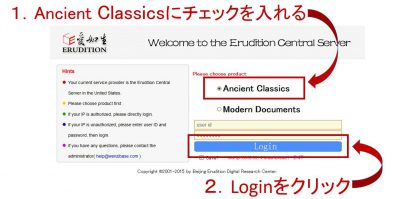The Zhongguo Jiben Guji Ku
Preamble
U-PARL installed the large database Zhongguo jiben guji ku 中國基本古籍庫 (Database of Chinese Classic Ancient Books) (accessible from the university network), as the first large collection for the Asian Research Library.
This database, well-known among Sinologists, is one of the foremost databases in the world, and the University of Tokyo had for a long time been keen to install it. In order to help researchers not only of Chinese studies but also in other fields of research gain an understanding of its appeal and academic value, in the following I wish to present a brief overview of the Zhongguo jiben guji ku.
What Is the Zhongguo Jiben Guji Ku?
The Zhongguo jiben guji ku is a large database produced by the Chinese company Airusheng 愛如生, and it contains approximately 10,000 texts from the pre-Qin period through to the Republican period. It is about three times larger than the Siku quanshu 四庫全書, compiled with the full resources of the Qing dynasty in the eighteenth century, and provides access to knowledge about all fields of study pertaining to China, including philosophy, literature, language, history, art, and religion.
Among texts not found in the Siku quanshu, this database includes works of popular literature such as the Shange 山歌 in 10 fascicles compiled by Feng Menglong 馮夢龍 of the late Ming, which brings together 380 songs of the Suzhou region, and the early-Qing play Changsheng dian 長生殿 by Hong Sheng 洪昇, which portrays the love story of the emperor Xuanzong 玄宗 and his consort Yang Guifei 楊貴妃, as well as such works as the Shaolin gunfa 少林棍法 in 3 fascicles, a Ming work on martial arts by Cheng Zongyou 程宗猷, and the Zhoupu 粥譜 (not divided into fascicles), a cooking book of the Qing period by Huang Yungu 黄雲鵠.
This database has two distinctive features:
1. All texts are fully searchable.
2. It includes photographic images of the original texts (including rare works and editions not available in Japan).
According to Airusheng’s Web site, the Zhongguo jiben guji ku is widely used not only in China, but also overseas, and it is becoming an indispensable resource for Sinologists around the world. A list of the texts included can be found on the Web site of the Japanese bookstore Tōhō Shoten 東方書店 (http://www.toho-shoten.co.jp/er07/187286.html), and there is also a detailed explanation of how to search the database, as well as a link to an automated demonstration of its use.
In the field of Chinese studies, full-text databases were in general use already before 2006, when the Zhongguo jiben guji ku was put on sale. Ranging from very expensive databases to relatively cheap databases that can be purchased for a few hundred dollars, they are almost all fully searchable. Airusheng too has produced fifteen large databases, including the Zhongguo suwen ku 中國俗文庫, containing about 10,000 works of popular literature, and the Zhongguo fangzhi ku 中國方志庫, containing about 10,000 local gazetteers, but it also sells smaller databases for individual users. The number of such databases will continue to grow in the future, but as is indicated by its name, the Zhongguo jiben guji ku could be described as the most basic and comprehensive of such databases.
The Zhongguo Jiben Guji Ku and Chinese Studies
In recent years the milieu of Chinese studies has undergone enormous change. The number of scholarly works being published in various areas of study is steadily increasing, and collections of source materials consisting of several dozen or sometimes several hundred volumes are being published one after another. In addition, databases such as those mentioned above, both large and small, are also being sold. It could be said that since the start of the twenty-first century the milieu of Chinese studies has been rapidly changing.
In particular, the popularization of the Zhongguo jiben guji ku has been having an enormous impact on research. In some cases, what previously took several months or more than a year to investigate can now be achieved in a few hours.
The texts contained in the Zhongguo jiben guji ku are divided into four sections—Philosophy and Science, History and Geography, Art and Literature, and General Works—and these are further divided into twenty major categories, which are in turn subdivided into one hundred minor categories. Because it is possible search across all these fields, someone specializing, for example, in history may “discover” material in the areas of philosophy or literature with which he had not been familiar and which had not been utilized in past historical research. Again, by investigating changes in the frequency of the usage of a certain term, it also becomes possible to gain all sorts of insights and ideas about the linguistic, philosophical, and cultural characteristics of a particular period.
When using the Zhongguo jiben guji ku, one may feel the same intellectual excitement as that experienced when opening an old Chinese book—the anticipation that one may make some new discovery or come across some new, unexpected material.
Concluding Remarks
The Uehiro Project for the Asian Research Library decided to install the Zhongguo jiben guji ku as the first large database for the Asian Research Library. It will be several years before the Asian Research Library is officially established, but in the meantime the Zhongguo jiben guji ku can be accessed via the university’s local area network. Of course, not all Chinese texts can be searched by means of the Zhongguo jiben guji ku. Depending on the period or topic, there will be many texts that are not included in this database. With the Zhongguo jiben guji ku as a central pillar, the Asian Research Library plans to actively add texts that are not included in this database.
We hope that the Zhongguo jiben guji ku will be widely used by both established researchers and undergraduate students about to enter the path of scholarship, and that it will serve as a new portal to the world of knowledge about the Chinese classics and, more broadly, the Sinographic cultural sphere that extends over a wide area of Asia.
Accessible from the university network (up tp 5 users simultaneously).



